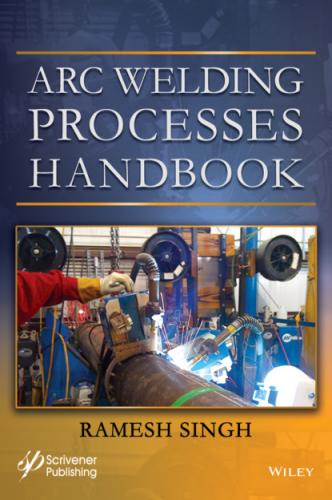Figure 7.23 Symbol of a plug weld
Figure 7.24 Shows symbols of plug and slot welds, with weld sizes, spacing and depth of the weld
List of Tables
Table 1.2 Arc efficiency by welding process
Table 1.3 Shows the arc efficiency factors for various commonly used arc welding processes
Table 1.5 Arc efficiency factor
Table 2.8.3.1 Welding lead and their capacity
Table 2.9.1 Welding lens shades
Table 2.9.2 Helmets with auto adjusting lenses
Table 2.10.1 Electrode classification and A-numbers
Table 2.10.2 Shielded arc welding electrodes
Table 2.11.10 Common SMAW process anomalies and their suggested causes and corrections
Table 2.11.12 Weld defects and suggested changes that can correct them
Table 2.12.1 Aluminum alloy designation system
Table 2.12.5 Cast aluminum designation and numbering system
Table 2.12.6 Temper designation letters and meaning
Table 2.12.23 Stainless steel welding electrodes and heat treatments
Table 2.13 Nominal compositions of some of duplex steels
Table 2.13.1 Nominal mechanical properties of duplex stainless steels
Table 3.10.1 Basic matching guide for electrode size and nozzle
Table 3.11.1 Tungsten electrode tips
Table 3.11.2 Tungsten electrode tips
Table 3.11.3 Types of Tungsten electrode and their identification
Table 3.16.1 Welding cable current carrying capacity
Table 3.17.1 Details the NEMA rating and corresponding current output capacity
Table 3.21.1 Aluminum alloy designation system
Table 3.22.1 Cast aluminum designation and numbering system
Table 3.24.1 Aluminum welding procedures using AC high frequency stabilized arc
Table 3.24.2 GTAW stainless steel welding procedures
Table 3.25.1 Nominal compositions of some of duplex steels
Table 3.25.8 Stainless steel welding wire rod and heat treatments
Table 3.6.2 Nominal mechanical properties of duplex stainless steels
Table 3.29.1 Advantages and limitations of PAW process
Table 4.4.1 Deposition rate of various GMAW metal transfer mode
Table 4.4.1.1 WPS for carbon steel and low alloy steels with short circuit transfer mode
Table 4.4.1.2 Aluminum WPS for short circuit
Table 4.4.1.3 The transition current for spray transfer currents
Table 4.4.1.4.1 Carbon steel – Basic training WPS for spray transfer welding
Table 4.4.1.4.2 Aluminum – Basic training WPS for spray transfer welding
Table 4.5.1 Details the current and the shielding gas type used in spray transfer mode of some of the common materials
Table 4.5.5.1 Gas selection guide
Table 4.12.1.4 Welding lead current carrying capacity
Table 5.5.1 Carbon steel electrodes their use descriptions
Table 5.6.6.1 Impact of shielding gases on the mechanical properties of weld metal
Table 6.10.7 Indicates the basicity of various fluxes
Table 6.11 Common welding electrodes for SAW process
Table 7.1 Pipe schedule
Table 7.2 Terms and abbreviations relating to welding and construction
Table 7.3 F-Number, ASME specification and AWS classification
Table 7.4 P-number, group number, and type of material
Table 7.5 Qualification of metals based on the procedure qualification
Table 7.6 Temperature conversion
Table 7.7 Temperature and pressure
Foreword
The book, “Arc Welding Processes Handbook”, brings together salient knowledge of arc welding methods used primarily in the industry and especially in the oil patch. The information presented about the welding process is usable and emulates the presence of your own welding engineer. Covering such welding methods as SMAW, GTAW, GMAW, FCAW and SAW with details in materials and techniques. This book is useful to both new welders as well as experienced welders. In the book, Ramesh covers these welding processes, how they work, and dives into the electrical side of welding. Welding machines, Transformers, Generators, Invertors, AC, DC, Sq. wave, Sine wave currents, Rectifiers, SCRs, Diodes, etc., as current control methods, all these are presented in a way that is easy to understand the functions of various welding machines. Most common weldable materials are discussed with welding guidance given that includes Aluminum, Nickel, Carbon steels, Stainless steels, Precipitation Hardened steels, Duplex Stainless steels, and others. The book is super comprehensive, easy to follow, and a welcome addition to any welding engineer’s bookcase. It is a truly great guide for any budding engineer or welder to help them master their skills.
David Ammerman Project Director at Gulf Interstate Engineering, MME, Texas PE 30+ years past-member of ASME, and member of API Committee: Pipeline Construction Voting Group
